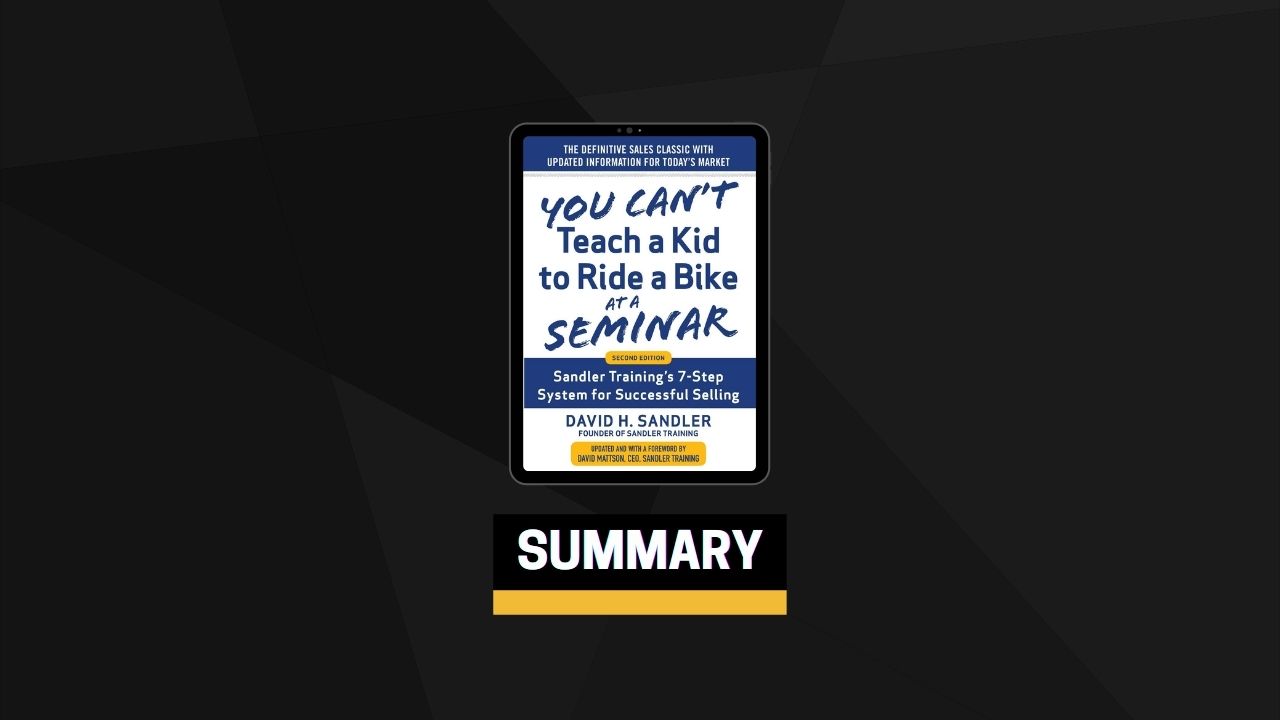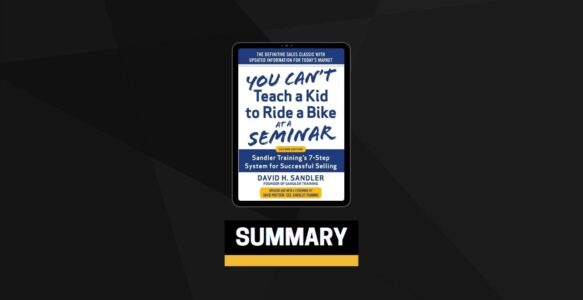Five Steps to Help You Master the Selling Dance
Learning how to sell professionally is a lot like learning how to ride a bicycle. People don’t learn to sell at a seminar, but the reinforcement training of a seminar is helpful. Nor do people learn how to sell from CDs, books, and videos, but these, too, are useful tools, like training wheels or a balancing hand.
To conquer the art of professional selling, you need to learn a system. You need to master techniques (but not traditional sales techniques), and you need to be nurtured and supported—not for a day or two, but for months, if not years.
To succeed in sales, you must observe only five rules:
- Qualify your prospects.
- Extract your prospect’s pain.
- Verify that the prospect has money.
- Be sure the prospect is a decision maker.
- Match your service or product to the prospect’s pain.
That’s it. Learn these five rules and you’ll master the art of professional selling.
Ideally, the salesperson and the prospect should think of selling as a win-win situation. The playing field should be level in sales, but it’s not. And that’s one of the goals of this book: to level the playing field so that the salesperson and the prospect can play fairly.
To begin leveling the playing field, every salesperson needs to understand that there are four truths in the prospect’s selling system.
The Four Harsh Truths About Prospects
Truth #1. Prospects don’t always tell you the truth, and they play their cards close to the vest.
Too many of today’s sales trainers are still touting the old-school curriculum. As a result, they are making salespeople work all the harder. If you use traditional selling techniques, you ought to know that your playbook is open to the prospect even before the sales call begins!
There’s even a deeper reason why prospects mislead you. Think about this: Did your mother raise you to go into sales? Absolutely not! Why not?
Let’s think of some words commonly used to describe a salesperson: Pushy, Liar, Polyester snake-oil barker.
What’s the easiest way for prospects to defend themselves? Mislead you. The two most familiar pieces of misdirection sound like this:
- “I’m not interested,” when in fact, interest could be generated under more favorable conditions
- “I’m interested,” when in fact, the prospect really isn’t interested but is afraid of the pressure that might be applied following an honest reply
What you need to understand as a salesperson is that it doesn’t matter what prospects say. They reserve the right to mislead you, tell you half-truths and generally throw you off track.
Truth #2. The prospect wants to know what you know.
Prospects want to extract all you know about your product or service, and they want to negotiate down your best price, just to beat up their existing suppliers. They need to know your numbers so they can say to your competition, “I have a better price than you’re giving me.” And imagine this: thousands of salespeople in your community are working hard to fulfill this need! As a result, they’re corrupting your marketplace.
Truth #3. The prospect commits to nothing.
Prospects who don’t get all they’re after during the initial sales discussion will ask the salesperson to do a little more work, a little more unpaid consulting. It sounds like this: “I need to think this over.” Or, “I’ll get back to you.” Or, “This is very interesting. I’d like to take this to committee.”
Truth #4. The prospect doesn’t answer the telephone and won’t return your messages.
What’s really happening? It’s over. Only you haven’t been told it’s over. And since you’ve been taught, by the traditional sales trainers, to follow through and hang in there, you’re stuck at the end of the prospect’s system. Of course, it’s been over for quite some time. You couldn’t admit it, though, because you invested so much effort and time chasing what you thought was a real opportunity. It wasn’t.
The Five Steps of Sandler’s Sales System
Sandler Training has developed a sales system that’s more powerful than the prospect’s, and here’s how it works:
Step 1.
You must uncover your prospect’s pain. People buy emotionally, but they make decisions intellectually. What’s the most intense emotion? Pain.
Without pain, there’s no easy sale. Perhaps there’s no sale at all. Without pain, people will continue to do what they’ve done all their lives until maintaining the status quo becomes so painful that something new is required. Unless you learn to uncover a prospect’s pain, you will continue to sell using the most difficult of traditional selling principles: the law of averages!
Step 2.
You must get all the money issues out on the table. While you need to discuss the cost of your product or service, it’s more important to discuss the cost to your prospects if they do nothing. Deal with money so that you can get paid for what you do. Once you uncover the prospect’s pain and you know money is available to get rid of the pain, you can progress to the third step.
Step 3.
You must discover the decision-making process your prospect uses when deciding to buy or not to buy a product or service. Is the prospect empowered to make the decision alone? Will an associate or spouse be involved in the decision making? Does the prospect like to think things over and decide later? Ultimately, can the prospect make the decision to spend the money to get rid of the pain?
Step 4.
You must present a solution that will get rid of the prospect’s pain. Traditionalists would now say, “Aha, this is where you talk features and benefits.” No, you don’t!
Your sales presentation has little to do with the features and benefits touted by the marketing department and everything to do with showing your prospect that your product or service can eliminate the pain.
Contrary to what the traditionalists say, prospects do not buy features and benefits. They buy things to help them overcome or avoid pain. All you need to do is show your prospects that your product or service will eliminate their pain. It’s as simple as that.
Step 5.
You must post-sell your sale. How often have your sales slipped away after you’ve concluded the sale? Perhaps it doesn’t happen in your business. But when a salesperson takes business away from a competitor, the competitor usually doesn’t surrender. Has your competitor ever sent you a congratulatory note that says, “Nice going, George! Good luck with your new client”?
Chances are, the competitor will make a run at saving the business. How? By lowballing your price. Once the gloves are off, the competitor isn’t going to be pleasant about it. Without a Post-Sell step you may get assaulted by your competitor. A strong and effective Post-Sell step will prevent your new customer from contacting you to say, “Please call. We need to talk.” Or, “Hold up temporarily. I’ve run into a problem.”
By following this five-step system, which is currently used successfully by countless sales professionals around the world, you can expect to win the selling dance the majority of the time.
Getting the Angle on Success
Ultimately, commitment is what counts. Are you willing to commit to be successful? If you are, and you apply the appropriate degree of commitment, success is yours. The combination of behavior, attitude, and technique will provide any level of success you desire. You need nothing more, or less. Apply your energies to each of these triangles, and you will own the Sandler Selling System.


